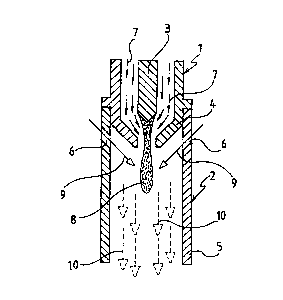Some of the information on this Web page has been provided by external sources. The Government of Canada is not responsible for the accuracy, reliability or currency of the information supplied by external sources. Users wishing to rely upon this information should consult directly with the source of the information. Content provided by external sources is not subject to official languages, privacy and accessibility requirements.
Any discrepancies in the text and image of the Claims and Abstract are due to differing posting times. Text of the Claims and Abstract are posted:
| (12) Patent Application: | (11) CA 2307590 |
|---|---|
| (54) English Title: | A PLASMA OZONE GENERATOR |
| (54) French Title: | GENERATEUR D'OZONE PLASMATIQUE |
| Status: | Deemed Abandoned and Beyond the Period of Reinstatement - Pending Response to Notice of Disregarded Communication |
| (51) International Patent Classification (IPC): |
|
|---|---|
| (72) Inventors : |
|
| (73) Owners : |
|
| (71) Applicants : |
|
| (74) Agent: | MARKS & CLERK |
| (74) Associate agent: | |
| (45) Issued: | |
| (86) PCT Filing Date: | 1998-10-29 |
| (87) Open to Public Inspection: | 1999-05-14 |
| Examination requested: | 2003-10-29 |
| Availability of licence: | N/A |
| Dedicated to the Public: | N/A |
| (25) Language of filing: | English |
| Patent Cooperation Treaty (PCT): | Yes |
|---|---|
| (86) PCT Filing Number: | PCT/IT1998/000302 |
| (87) International Publication Number: | WO 1999023031 |
| (85) National Entry: | 2000-04-28 |
| (30) Application Priority Data: | ||||||
|---|---|---|---|---|---|---|
|
A plasma ozone generator, in particular of the kind with a mean to high ozone
production capacity between 1 and 15 kg/h, comprising a plasma electric torch
(1) in which, at a high temperature and starting from molecular oxygen (7), a
first flow of monoatomic oxygen flow (8) is generated, and a reaction chamber
(2) downstream of said torch, in which the first monoatomic oxygen flow (8)
interacts with a second cryogenic liquid oxygen flow (9), generating a flow
(10) of a cooled gaseous mixture, consisting of ozone and molecular oxygen.
L'invention concerne un générateur d'ozone plasmatique, en particulier du type qui comprend un organe présentant une forte capacité de production d'ozone, soit entre 1 et 15 kg/h. Ce générateur comprend tout d'abord une lampe électrique plasmatique (1) destinée à générer, à une température élevée et à partir d'oxygène moléculaire, un courant d'oxygène monoatomique (8). Ce générateur comprend également une chambre de réaction (2), située en aval par rapport à ladite lampe, et dans laquelle le courant d'oxygène monoatomique (8) interagit avec un second courant, renfermant de l'oxygène liquide cryogène (9), ce qui permet de générer un courant (10) d'un mélange gazeux refroidi à base d'ozone et d'oxygène moléculaire.
Note: Claims are shown in the official language in which they were submitted.
Note: Descriptions are shown in the official language in which they were submitted.

2024-08-01:As part of the Next Generation Patents (NGP) transition, the Canadian Patents Database (CPD) now contains a more detailed Event History, which replicates the Event Log of our new back-office solution.
Please note that "Inactive:" events refers to events no longer in use in our new back-office solution.
For a clearer understanding of the status of the application/patent presented on this page, the site Disclaimer , as well as the definitions for Patent , Event History , Maintenance Fee and Payment History should be consulted.
| Description | Date |
|---|---|
| Inactive: IPC from MCD | 2006-03-12 |
| Inactive: IPC from MCD | 2006-03-12 |
| Application Not Reinstated by Deadline | 2005-10-31 |
| Time Limit for Reversal Expired | 2005-10-31 |
| Deemed Abandoned - Failure to Respond to Maintenance Fee Notice | 2004-10-29 |
| Letter Sent | 2003-11-19 |
| All Requirements for Examination Determined Compliant | 2003-10-29 |
| Request for Examination Received | 2003-10-29 |
| Request for Examination Requirements Determined Compliant | 2003-10-29 |
| Inactive: Office letter | 2001-12-05 |
| Inactive: Cover page published | 2000-07-12 |
| Inactive: First IPC assigned | 2000-06-20 |
| Inactive: Notice - National entry - No RFE | 2000-06-15 |
| Application Received - PCT | 2000-06-09 |
| Application Published (Open to Public Inspection) | 1999-05-14 |
| Abandonment Date | Reason | Reinstatement Date |
|---|---|---|
| 2004-10-29 |
The last payment was received on 2003-10-29
Note : If the full payment has not been received on or before the date indicated, a further fee may be required which may be one of the following
Please refer to the CIPO Patent Fees web page to see all current fee amounts.
| Fee Type | Anniversary Year | Due Date | Paid Date |
|---|---|---|---|
| Basic national fee - small | 2000-04-28 | ||
| MF (application, 2nd anniv.) - small | 02 | 2000-10-30 | 2000-04-28 |
| MF (application, 3rd anniv.) - small | 03 | 2001-10-29 | 2001-10-24 |
| MF (application, 4th anniv.) - small | 04 | 2002-10-29 | 2002-10-24 |
| Request for examination - small | 2003-10-29 | ||
| MF (application, 5th anniv.) - small | 05 | 2003-10-29 | 2003-10-29 |
Note: Records showing the ownership history in alphabetical order.
| Current Owners on Record |
|---|
| GIUSEPPE FRANCESCONI |
| Past Owners on Record |
|---|
| None |